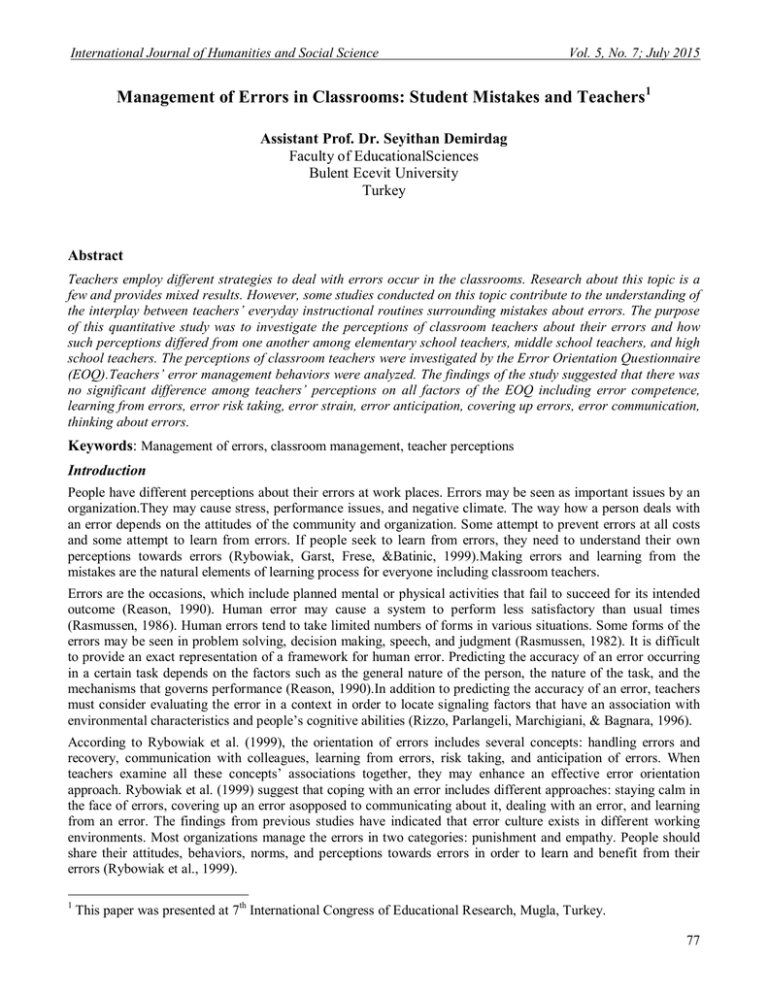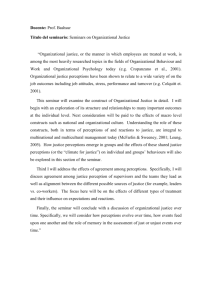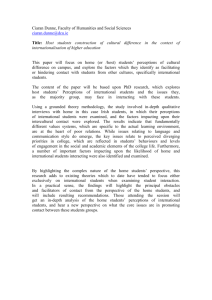Management of Errors in Classrooms: Student Mistakes and Teachers Abstract
advertisement

International Journal of Humanities and Social Science Vol. 5, No. 7; July 2015 Management of Errors in Classrooms: Student Mistakes and Teachers1 Assistant Prof. Dr. Seyithan Demirdag Faculty of EducationalSciences Bulent Ecevit University Turkey Abstract Teachers employ different strategies to deal with errors occur in the classrooms. Research about this topic is a few and provides mixed results. However, some studies conducted on this topic contribute to the understanding of the interplay between teachers’ everyday instructional routines surrounding mistakes about errors. The purpose of this quantitative study was to investigate the perceptions of classroom teachers about their errors and how such perceptions differed from one another among elementary school teachers, middle school teachers, and high school teachers. The perceptions of classroom teachers were investigated by the Error Orientation Questionnaire (EOQ).Teachers’ error management behaviors were analyzed. The findings of the study suggested that there was no significant difference among teachers’ perceptions on all factors of the EOQ including error competence, learning from errors, error risk taking, error strain, error anticipation, covering up errors, error communication, thinking about errors. Keywords: Management of errors, classroom management, teacher perceptions Introduction People have different perceptions about their errors at work places. Errors may be seen as important issues by an organization.They may cause stress, performance issues, and negative climate. The way how a person deals with an error depends on the attitudes of the community and organization. Some attempt to prevent errors at all costs and some attempt to learn from errors. If people seek to learn from errors, they need to understand their own perceptions towards errors (Rybowiak, Garst, Frese, &Batinic, 1999).Making errors and learning from the mistakes are the natural elements of learning process for everyone including classroom teachers. Errors are the occasions, which include planned mental or physical activities that fail to succeed for its intended outcome (Reason, 1990). Human error may cause a system to perform less satisfactory than usual times (Rasmussen, 1986). Human errors tend to take limited numbers of forms in various situations. Some forms of the errors may be seen in problem solving, decision making, speech, and judgment (Rasmussen, 1982). It is difficult to provide an exact representation of a framework for human error. Predicting the accuracy of an error occurring in a certain task depends on the factors such as the general nature of the person, the nature of the task, and the mechanisms that governs performance (Reason, 1990).In addition to predicting the accuracy of an error, teachers must consider evaluating the error in a context in order to locate signaling factors that have an association with environmental characteristics and people’s cognitive abilities (Rizzo, Parlangeli, Marchigiani, & Bagnara, 1996). According to Rybowiak et al. (1999), the orientation of errors includes several concepts: handling errors and recovery, communication with colleagues, learning from errors, risk taking, and anticipation of errors. When teachers examine all these concepts’ associations together, they may enhance an effective error orientation approach. Rybowiak et al. (1999) suggest that coping with an error includes different approaches: staying calm in the face of errors, covering up an error asopposed to communicating about it, dealing with an error, and learning from an error. The findings from previous studies have indicated that error culture exists in different working environments. Most organizations manage the errors in two categories: punishment and empathy. People should share their attitudes, behaviors, norms, and perceptions towards errors in order to learn and benefit from their errors (Rybowiak et al., 1999). 1 This paper was presented at 7th International Congress of Educational Research, Mugla, Turkey. 77 ISSN 2220-8488 (Print), 2221-0989 (Online) ©Center for Promoting Ideas, USA www.ijhssnet.com It is important to understand that errors made by classroom teachers may have a substantial effect on student learning (Roeser, Midgley, & Urdan, 1996). Teachers’ attitudes towards errors are likely to influence how students develop conceptions on how to learn from their own mistakes (Steuer & Dresel, 2011). Research shows that teachers’ misconceptions towards their errors are likely to increase students’ failures as students may develop a maladaptive pattern on dealing with their mistakes (Dweck, 1986). Such patterns create negative effect on students as they may start to avoid academically challenging courses (Goetz, Pekrun, Hall, & Haag, 2006). In addition, students may develop negative feelings about subjects related to the school and learning. Whereas empirical research has mainly focused on the macro level of how different organizations similarly manage errors, less is known about how teachers and schools manage errors in different countries (Clarke, Emanuelsson, Jablonka, &Mok, 2006). It may be concluded that learning from errors depends on the perceptions of teachers and the culture of the schools (Givvin, Hiebert, Jacobs, Hollingsworth, & Gallimore, 2005; Le Tendre, Baker, Akiba, Goesling & Wiseman, 2001). Research indicates that teachers’ perceptions towards errors may influence their teaching practices and student learning (Ames, 1992). Some studies suggest that teachers’ mastery about errors affect students’ perceptions on errors (Cobb, Stephan, McClain, &Gravemeijer, 2001; Depaepe, DeCorte, & Verschaffel, 2006). Consequently, it is assumed that everyday error related practices of teachers may have an impact on the error culture of the classroomand the attitudes of students towards mistakes (Cobb et al., 2001). Attitudes of teachers towards errors may create a positive or negative classroom climate depending how they conceive their mistakes (Meyer, Seidel, & Prenzel, 2006). Students may learn from their mistakes when they are encouraged by teachers about how to discuss about their misconceptions on mistakes that they have made (Heimbeck, Frese, Sonnentag, & Keith, 2003). It has been seen that the existence ofpositive error climate depends on a classroom with clear standards and trustful learning environment (Goldin, Epstein, &Schorr, 2007; Spychiger, Kuster, & Oser, 2006). If teachers employ positive perceptions towards mistakes, students will take more initiatives to participate in learning tasks as they would know that they will not be ridiculed due to their mistakes (Edmondson, 1999; Tulis & Riemenschneider, 2008). In contrast, if students are being ridiculed, punished, and ignored due to their errors, they will tend to cover up their mistakes and avoid taking risks in learning activities (Rybowiak et al., 1999). Learning is an active process that allows people to learn in both procedural and conceptual ways. Therefore, classroom settings should encourage teachers to explore and discuss their errors (Hiebert & Carpenter, 1992; Reusser, 2000). Although constructivist approaches support adaptive ways of dealing with errors and learning from mistakes, little is known about the attitudes of classroom teachers on dealing with their errors.As a result, classroom teachers need to learn from their errors and be sensitive to students’ errors so that they may be able to develop a positive learning environment that encourages all students to engage in learning activities. Teachers’ positive attitudes towards their errors may eventually create a classroom environment, which is constituted by the quality of learning experiences within error situations. Although it is known that teachers’ errors may have a negative effect on student learning, research is lacking about the perceptions of teachers on their errors. Therefore, the goal of this study was to investigate the perceptions of classroom teachers about their own errors. In line with this aim, the following research questions were investigated: 1. What are the perceptions of classroom teachers about their own errors? 2. How do the perceptions of elementary school teachers, middle school teachers, and high school teachers differ from one another about their errors? Table 1: Percentages of Teachers Participating in the Study Group Elementary School Teacher Middle School Teacher High School Teacher Total Frequency 32 36 30 98 Percent 32.7 36.7 30.6 100.0 Cumulative Percent 32.7 69.4 100.0 Methodology Setting This quantitative study was conducted at four elementary schools, four middle schools, and four high schools in the Midwestern United States. There were about 700 teachers teaching at these schools. 78 International Journal of Humanities and Social Science Vol. 5, No. 7; July 2015 Teachers’ teaching experiences varied from 1 year to 29 years. The schools had a diverse student population including Hispanic students at 78%, African - American students at 12%,Caucasian students 6%, and the other students at 4%. The schools were located at economically disadvantaged areas. Therefore, most of the students (83%) received free or reduced lunch. Table 2: Percentages of Genders Participating in the Study Group Female Male Total Frequency 52 46 98 Percent 53.1 46.9 100.0 Cumulative Percent 53.1 100.0 Sample The study included a non-equivalent and a non-random sample from several elementary schools, middle schools, and high schools. The number of participants included 32 elementary school teachers, 36 middle school teachers, and 30 high school teachers with varying years of teaching experience (see Table 1). A questionnaire consisted of 37 items was given to the study participants to be answered within 45 minutes. The sample included 52 female and 46 male participants (Table 2) in the study. The Instrument This study included a questionnaire called the Error Orientation Questionnaire (EOQ).The questionnaire was developed by Rybowiak et al. (1999). The instrument included 37 items and eight factors: Error competence (four items), Learning from errors (four items), Error risk taking (four items), Error strain (six items), Error anticipation (five items), Covering up errors (six items), Error communication (four items), and Thinking about errors (five items). The Likert scale instrument had five possible answers (1 = Not at all, 2 = A bit, 3 = Neither a bit, nor a lot, 4 = A lot, and 5 = Totally). Before the study was conducted, the instrument’s reliability was calculated by pilot testing to assess the coefficient alpha (Cronbach, 1951). After pilot testing the instrument with 38 teachers, the instrument was found to be reliable, as the coefficient alpha was 0.62. This value is considered to be acceptable. Data Analysis For the data collection, a questionnaire was used for all participants during the 2013-2014 academic school years. The participants were allowed about 45 minutes to answer all questions on the questionnaire. The participants answered 37 questions on the instrument. After the data were collected, they were imported into SPSS 20.0 for further analysis. The data were analyzed on the basis of the arithmetic mean, standard deviation, and one-way Anova. Results Teachers have different perceptions about how to deal with their errors occurring in the classrooms. The results are presented according to teachers’ mean scores on the items of the instrument. In addition, the perceptions of elementary school teachers, middle school teachers, and high school teachers about their errors occurring in the classrooms were compared based on eight factors: Factor 1: error competence, Factor 2: learning from errors, Factor 3: error risk taking, Factor 4: error strain, Factor 5: error anticipation, Factor 6: covering up errors, Factor 7: error communication, and Factor 8: thinking about errors. Table 3: Test of Homogeneity of Variances Dependent Variables Eror competence Learning from errors Error risk taking Error strain Error anticipation Covering up errors Error communication Thinking about errors Overall Levene Statistic .32 1.92 2.42 1.41 .60 1.54 .07 .99 1.21 df1 2 2 2 2 2 2 2 2 2 df2 95 95 95 95 95 95 95 95 95 Sig. .72 .15 .09 .24 .54 .21 .92 .37 .30 79 ISSN 2220-8488 (Print), 2221-0989 (Online) ©Center for Promoting Ideas, USA www.ijhssnet.com TheLevene’s test wasconductedto assess the homogeneity in variances. The test is necessary to examine whether the variables in the study are normally distributed. When examining the normality of distributions, the significant value of p should be bigger than .05. After running the Levene’s test, the significant values for all factors indicated normality as the significant values were bigger than .05 (see Table 3).These results showed that the variances did not vary too much among one another. Table 4: Summary of Ranges, Means, and Standard Deviations on Items of EOQ Dependent Variables Error competence Learning from errors Error risk taking Error strain Error anticipation Covering up errors Error communication Thinking about errors Items Item 1 Item 2 Item 3 Item 4 Item 5 Item 6 Item 7 Item 8 Item 9 Item 10 Item 11 Item 12 Item 13 Item 14 Item 15 Item 16 Item 17 Item 18 Item 19 Item 20 Item 21 Item 22 Item 23 Item 24 Item 25 Item 26 Item 27 Item 28 Item 29 Item 30 Item 31 Item 32 Item 33 Item 34 Item 35 Item 36 Item 37 N 98 98 98 98 98 98 98 98 98 98 98 98 98 98 98 98 98 98 98 98 98 98 98 98 98 98 98 98 98 98 98 98 98 98 98 98 98 Min-Max 2.00-5.00 1.00-5.00 2.00-5.00 1.00-5.00 1.00-5.00 1.00-4.00 1.00-4.00 1.00-5.00 1.00-5.00 1.00-5.00 1.00-5.00 1.00-5.00 1.00-5.00 1.00-5.00 1.00-5.00 1.00-5.00 1.00-5.00 1.00-5.00 2.00-5.00 1.00-5.00 1.00-5.00 1.00-5.00 1.00-5.00 1.00-5.00 1.00-5.00 1.00-5.00 1.00-5.00 1.00-5.00 1.00-5.00 1.00-5.00 1.00-5.00 1.00-5.00 1.00-5.00 1.00-5.00 1.00-5.00 1.00-5.00 1.00-5.00 Mean 3.95 3.26 3.58 2.62 3.66 1.98 1.98 1.75 3.87 3.77 2.97 3.14 2.79 3.45 2.90 3.87 3.65 2.69 3.82 2.02 3.38 2.71 3.62 2.00 1.96 1.85 3.60 3.74 2.88 3.11 2.71 3.11 2.81 3.63 3.53 2.72 3.46 SD .77 .90 .86 .98 .86 .76 .81 1.11 .99 1.05 1.16 .96 .99 1.01 1.12 .89 .96 .93 .91 .90 1.03 .97 1.03 .99 .97 .97 .94 1.04 1.20 1.07 .98 1.11 1.06 1.07 1.01 1.14 1.12 Note. EOQ = Error Orientation Questionnaire. The mean values on the factors – error competence, learning from errors, error risk taking, error strain, error anticipation, covering up errors, error communication, and thinking about errors– of EOQ instrument showed that most subscales had different mean scores (see Table 4). Teachers had the highest mean score on item 1 of error competence(M = 3.95, SD = .77) and the lowest mean score on item 8 of learning from errors(M = 1.75, SD = 1.11). 80 International Journal of Humanities and Social Science Vol. 5, No. 7; July 2015 Teachers had considerably high mean scores on item 9 of error risk taking(M = 3.87, SD = .99), item 16 of error strain(M = 3.87, SD = .89), item 19 of error anticipation(M = 3.82, SD = .91), item 28 of covering up errors(M = 3.74, SD = 1.04), and item 34 of thinking about errors(M = 3.63, SD = 1.07). On the other hand, teachers scored considerably low scores on item 6 of learning from errors (M = 1.98, SD = .76), item 7 of learning from errors (M = 1.98, SD = .81), item 25 of covering up errors (M = 1.96, SD = .97), and item 26 of covering up errors (M = 1.85, SD = .97). Table 5: Summary of Ranges, Means, and Standard Deviations on Dispositions of EOQ Dependent Variables Error competence Learning from errors Error risk taking Error strain Error anticipation Covering up errors Error communication Thinking about errors Overall Elementary School Teachers N Mean SD Middle School Teachers High School Teachers N Mean SD N Mean SD 32 32 3.46 2.44 .51 .57 36 36 3.23 2.28 .47 .37 30 30 3.38 2.32 .61 .53 32 32 32 32 3.46 3.42 2.93 2.88 .78 .57 .45 .61 36 36 36 36 3.40 3.36 2.85 2.74 .65 .53 .38 .41 30 30 30 30 3.46 3.22 3.02 2.75 .53 .44 .43 .39 32 2.85 .60 36 2.98 .53 30 3.03 .58 32 3.06 .64 36 3.23 .53 30 3.41 .65 32 3.06 .31 36 3.01 .21 30 3.06 .23 Note. EOQ = Error Orientation Questionnaire. The mean scores among teachers were analyzed and the results showed that elementary school teachers, middle school teachers, and high school teachers had different mean scores on each factor of EOQ (see Table 5). Elementary school teachers had higher mean scores on error competence(M = 3.46, SD = .51), learning from errors(M = 2.44, SD = .57), error strain(M = 3.42, SD = .57), and covering up errors(M = 2.88, SD = .61) than middle school teachers, and high school teachers. On the other hand, high school teachers had higher mean scores on error risk taking(M = 3.46, SD = .53), error anticipation(M = 3.02, SD = .43), error communication(M = 3.03, SD = .58), and thinking about errors(M = 3.41, SD = .65) than elementary school teachers, and middle school teachers Table 6: One-way Anova Test Results between Groups Dependent Variables Error competence Learning from errors Error risk taking Error strain Error anticipation Covering up errors Error communication Thinking about errors Overall Sum of Squares .94 .46 .06 .67 .47 .41 .56 1.90 .06 df 2 2 2 2 2 2 2 2 2 Mean Square .47 .23 .03 .34 .23 .20 .28 .95 .03 F 1.63 .93 .07 1.23 1.31 .88 .85 2.54 .50 Sig. .20 .39 .92 .29 .27 .41 .42 .08 .60 Data analysis from Anova tests showed that there were not any significant differences on mean scores among teachers on all factors of the EOQ.Teachers had non-significant mean scores on error competence, with conditions F(2, 95) = 1.63, p = .20, η2 = .47, on learning from errors, with conditions F(2, 95) = .93, p = .39, η2 = .23, on error risk taking,with conditions F(2, 95) = .07, p = .92, η2 = .03, on error strain, with conditions F(2, 95) = 1.23, p = .29, η2 = .34,on error anticipation, with conditions F(2, 95) = 1.31, p = .27, η2 = .23, on covering up errors, with conditions F(2, 95) = .88, p = .41, η2 = .20, on error communication, with conditions F(2, 95) = .85, p = .42, η2 = .28, and on thinking about errors, with conditions F(2, 95) = 2.54, p = .08, η2 = .95. 81 ISSN 2220-8488 (Print), 2221-0989 (Online) ©Center for Promoting Ideas, USA www.ijhssnet.com Discussion This study investigated the perceptions of classroom teachers about their errors and how such perceptions differed from one another among elementary school teachers, middle school teachers, and high school teachers. Analyzing the perceptions of classroom teachers about their errors, the findings showed that there was no significant difference among teachers’ perceptions on all factors of the EOQ including error competence, learning from errors, error risk taking, error strain, error anticipation, covering up errors, error communication, thinking about errors. Although classroom teachers had different perceptions about their own errors, none of these perceptions were meaningful. This result indicates that schools may have similar error management cultures.In their study, Clarke et al. (2006) suggested that workers of different organizations have commonalities in managing errors. In similar studies, Givvin et al. (2005) and Le Tendre et al. (2001) found that the ways how teachers deal with errors depend on the perceptions of the teachers and schools’ culture.Rasmussen (1986) found that how people perceive their mistakes depends on the general nature of people and how they evaluate their errors. When the perceptions of elementary school teachers, middle school teachers, and high school teachers were compared on the basis of error competence, learning from errors, error risk taking, error strain, error anticipation, covering up errors, error communication, thinking about errors, the results showed that there were no significant differences among these grade level teachers. Although the difference on perceptions of different grade level teachers was not meaningful, the perceptions of elementary school teachers and high school teachers were more positive than middle school teachers. Previous research has indicated that teachers may have different perceptions towards errors made in the classroom, and that such perceptions could affect student learning (Ames, 1992). In parallel studies, Cobb et al. (2001) and Depaepe et al. (2006) found that how teachers perceive errors may eventually influence students’ understanding of errors, which may be positive or negative. Having positive attitudes towards errors in the classroom are crucial because teachers affect students in many ways including their behaviors and misconceptions towards errors (Heimbeck et al., 2003). In addition, teachers, who have established clear standards and positive classroom settings tend to be more successful in encouraging students in meaningful learning tasks as students know that even if they make any mistakes in such learning environments, they would not be ridiculed by anyone in the classroom (Goldin et al., 2007; Heimbeck et al., 2003; Spychiger et al., 2006). The study included several limitations. First, the time constraints did not allow the researcher to collect data from more schools. Such constraints limited the generalizability of the study results. Second, the study took place mainly in economically disadvantaged locations of the school district. Conducting research in diverse locations of the school district would provide a more comparable and clearer picture of the outcomes. Efforts for the future study should build on the perceptions of teachers from different school settings across the state. In addition, future research should build on these findings by replicating data-informed results for educational leaders at different school settings. The findings from the study showed that although the perceptions of classroom teachers were somewhat different from one another, the results were not meaningful. Previous studies have suggested that learning is an active process. Therefore, classroom teachers should be encouraged to explore and discuss their mistakes. Learning from the errors would eventually help teachers to be more sensitive to students’ mistakes so that students would understand the fact that making mistakes is a part of learning and includes no punishment by others. It is evident that trustful and positive learning settings have positive impacts on student learning. As a result, leaders in education should take strong measures to help increase classroom teachers’ understanding of errors. In addition, they must provide professional development and seminars for teachers so that they would know that making errors is part of the learning process and that such errors may create opportunities for a democratic and positive learning environment. References Ames, C. (1992). Classrooms: goals, structures, and student motivation. Journal ofEducational Psychology, 84, 261-271. Clarke, D. J., Emanuelsson, J., Jablonka, E., &Mok, I. A. C. (2006). Making connections:Comparing mathematics classrooms around the world. Rotterdam: SensePublishers. Cobb, P., Stephan, M., McClain, K., &Gravemeijer, K. (2001).Participating in classroom mathematical practices. Journal of the Learning Sciences, 10, 113-163. Cronbach, L. J. (1951). Coefficientalphaandtheinternalstructure of tests. Psychometrika. 16, 297-334. 82 International Journal of Humanities and Social Science Vol. 5, No. 7; July 2015 Depaepe, F., DeCorte, E., &Verschaffel, L. (2006). The culture of the mathematics classroom: a complex determinant of students’ learning. In J. Elen& R. E. Clark (Eds.), Handling complexity in learning environments.Theory and research.Advancesin Learning and Instruction Series (pp. 89-106). Oxford: Elsevier. Dweck, C. (1986). Motivational processes affecting learning. American Psychologist, 41, 1040-1048. Edmondson, A. (1999). Psychological safety and learning behaviour in work teams. Administrative Science Quarterly, 44, 350-383. Givvin, K. B., Hiebert, J., Jacobs, J. K., Hollingsworth, H., &Gallimore, R. (2005). Are there national patterns of teaching? Evidence from the TIMSS 1999 video study. Comparative Education Review, 49, 311-342. Goetz, T., Pekrun, R., Hall, N., & Haag, L. (2006). Academic emotions from a social cognitive perspective: antecedents and domain specificity of students’ affect in the context of Latin instruction. British Journal of Educational Psychology, 76, 289-308. Goldin, G. A., Epstein, Y. M., &Schorr, R. Y. (2007). Affective pathways and structures in urban student’s mathematical learning. In D. K. Pugalee, A. Rogerson&A. Schinck (Eds.), Mathematics education in a global community: Proceedings of the 9th international conference of the mathematics education into the 21stcentury project (pp. 260-264). Charlotte, NC: Center for Mathematics, Science and Technology Education. Heimbeck, D., Frese, M., Sonnentag, S., & Keith, N. (2003).Integrating errors into the training process: the function of error management instructions and the role of goal orientation. Personnel Psychology, 56, 333-362. Hiebert, J., & Carpenter, T. P. (1992). Learning and teaching with understanding. In D. A. Grows (Ed.), Handbook of research on mathematics teaching and learning. New York: Macmillan. LeTendre, G. K., Baker, D. P., Akiba, M., Goesling, B., & Wiseman, A. (2001). Teachers’ work: institutional isomorphism and cultural variation in the U.S., Germany, and Japan. Educational Researcher, 30, 3-15. Meyer, L., Seidel, T., &Prenzel, M. (2006).WennLernsituationenzuLeistungssituationenwerden: UntersuchungzurFehlerkultur in einerVideostudie [If learning situations turn into performance situations: analyzing error culture in a video-study]. SchweizerischeZeitschriftfürBildungswissenschaften, 28, 21-41. Rasmussen, J. (1982). Human Errors: A Taxonomy for describing human malfunction in industrial installations. Journal of Occupational Accidents, 4, 311-335. Rasmussen, J. (1986). Information processing and human-machine interaction. Amsterdam: Elsevier Science Publishers B.V. Reason, J. (1990).Human Error. Cambridge: Cambridge University Press. Reusser, K. (2000). Success and failure in school mathematics: effects of instruction and school environment. European Child & Adolescent Psychiatry, 9, 17-26. Rizzo, A., Parlangeli, O, Marchigiani, E. and Bagnara, S. (1996). The Management of Human Errors in UserCentered Design. SIGCHI Bulletin, 28 (3), 6-10. Roeser, R.W., Midgley, C., &Urdan, T. (1996). Perceptions of the school psychological environment and early adolescents’ psychological and behavioral functioning in school: the mediating role of goals and belonging. Journal of Educational Psychology, 88, 408-422. Rybowiak, V., Garst, H., Frese, M., &Batinic, B. (1999). Error Orientation Questionnaire(EOQ): reliability, validity, and different language equivalence. Journal of Organizational Behavior, 20, 527-547. Spychiger, M., Kuster, R., &Oser, F. (2006).Dimensionen von Fehlerkultur in der Schule und ihreMessung.Der SchülerfragebogenzurFehlerkulturimUnterrichtfürMittel- und Oberstufe [Dimensions of error culture at school and its measurement].Revue suisse des sciences de l’éducation, 28, 87-110. Steuer, G., &Dresel, M. (2011). Dealing with errors in mathematics classrooms: the relevance of error climate and personal achievement motivation. In Paper presented at the 91. Annual Meeting of the American Educational Research Association (AERA) in New Orleans, USA. Tulis, M., &Riemenschneider, I. (2008).Self-concept, subject value and coping with failure in the math classroom e influences on students’ emotions.International Journal of Psychology, 43, 163. 83







